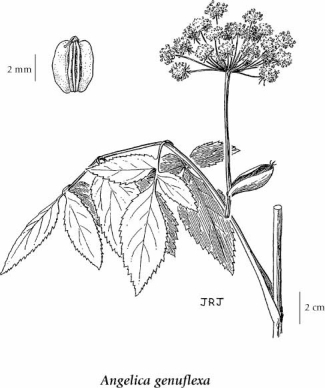kneeling angelica
Apiaceae
Introduction to Vascular Plants
Species Information
General:
Stout perennial herb from a taproot; stems 1-3 m, glabrous, hollow, arising from erect, tuberous, chambered stem-base, often purplish and glaucous.
Leaves:
Stem leaves compound with three major divisions that are in turn divided again; primary divisions bent back (not directed forward as in other similar species); leaf axis bent; leaflets reflexed, oblong to lanceolate, 4-10 cm long.
Flowers:
Inflorescence terminal, of umbrella-like clusters; flowers white or pinkish; involucral bracts lacking.
Fruits:
Rounded, 3-4 mm long, glabrous, with broadly winged lateral ribs.
Illustration

If more than one illustration is available for a species (e.g., separate illustrations were provided for two subspecies) then links to the separate images will be provided below. Note that individual subspecies or varietal illustrations are not always available.
Illustration Source: The Illustrated Flora of British Columbia
Ecology
The table below shows the species-specific information calculated from
original data (BEC database) provided by the BC Ministry of Forests and Range.
(Updated August, 2013)
| Site Information |
Value / Class |
||
|
Avg |
Min |
Max |
|
| Elevation
(metres) |
653 | 0 | 2205 |
| Slope
Gradient (%) |
3 | 0 | 86 |
|
Aspect (degrees) |
66 | 0 | 360 |
| Soil
Moisture Regime (SMR) [0 - very xeric; 4 - mesic; 8 - hydric] |
5 | 2 | 8 |
| Modal
Nutrient Regime
Class |
D | ||
| #
of field plots species was recorded in: |
468 | ||
| Modal
BEC Zone Class |
CWH | ||
|
All BEC Zones (# of stations/zone) species was recorded in |
BWBS(12), CDF(21), CWH(139), ESSF(51), ICH(63), IDF(10), MH(10), MS(4), SBPS(6), SBS(135), SWB(1) | ||
|
Source:
Klinkenberg 2013
|
|||
Habitat and Range
Moist streambanks and open forests in the montane zone; common throughout BC, infrequent in the Queen Charlotte Islands and the adjacent coast; amphiberingian, N to AK, E to AB and S to N CA; E Asia.Status Information
Taxonomic Keys
1. Fruits slightly flattened, the subequal wings scarcely winged; plants mainly coastal ................A. lucida
1. Fruits strongly flattened, the lateral wings broadly winged; plants not essentially coastal. 2. Flowers yellowish; involucres present, leafy........................ A. dawsonii 2. Flowers white, greenish-white or sometimes pinkish; involucres lacking or rarely a few bracts present. 3. Main axis of the leaves bent, leaflets deflexed....................... A. genuflexa 3. Main axis of the leaves straight, leaflets not deflexed....................... A. arguta |